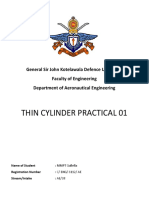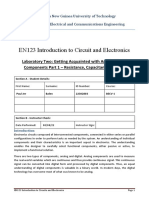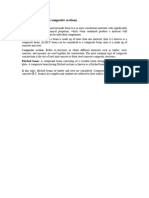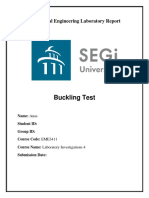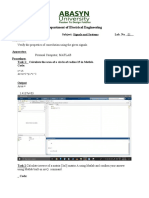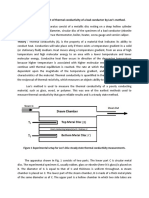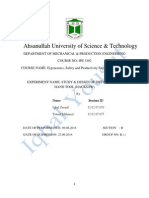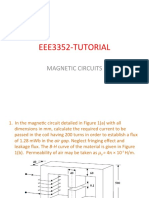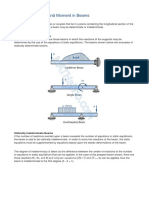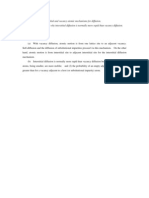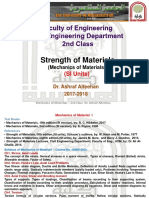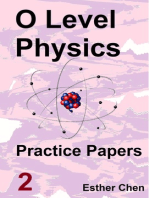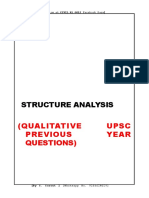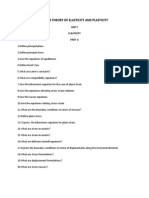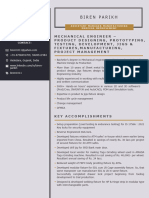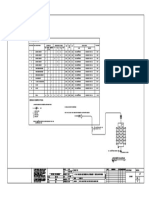Strength of Materials-II 2-2 Set-3 (A)
Strength of Materials-II 2-2 Set-3 (A)
Uploaded by
Sri DCopyright:
Available Formats
Strength of Materials-II 2-2 Set-3 (A)
Strength of Materials-II 2-2 Set-3 (A)
Uploaded by
Sri DOriginal Description:
Original Title
Copyright
Available Formats
Share this document
Did you find this document useful?
Is this content inappropriate?
Copyright:
Available Formats
Strength of Materials-II 2-2 Set-3 (A)
Strength of Materials-II 2-2 Set-3 (A)
Uploaded by
Sri DCopyright:
Available Formats
S.
32
Spectrum ALL-IN-ONE Journal for Engineering Students, 2014
Code No : 9A01401/R09
B.Tech II Year II Semester Regular and Supplementary Examinations
April/May - 2013
Set-3
Solutions
STRENGTH MATERIALS-II
( Civil Engineering )
Time: 3 Hours
Max. Marks: 70
Answer any FIVE Questions
All Questions carry Equal Marks
---
1.
A cast iron cylinder of 200 mm inner diameter and 12.5 mm thick is closely wound with a layer of 4 mm diameter steel
wire under a tensile stress of 55 MN/m2. Determine the stresses set up in the cylinder and steel wire if water under a
pressure of 3 MN/m2 is admitted in the cylinder. Take Ecast iron = 100 GN/m2, Esteel = 200 GN/m2 and Poissons ratio = 0.25.
(Unit-I, Topic No. 1.1)
2.
(a)
Stating assumptions derive Lames equations to find out the stresses in a thick cylindrical shell.
(Unit-II, Topic No. 2.1)
(b)
A hollow cylinder has an external diameter of 250 mm and thickness of the wall is 50 mm. The cylinder is
subjected to an internal fluid pressure = 35 MPa and external pressure = 3.5 MPa. Calculate the maximum and
minimum circumferential stresses and plot the variation of the same across the wall thickness.
(Unit-II, Topic No. 2.1)
3.
A hollow steel shaft of external diameter equal to twice the internal diameter, 5 m long is to transmit 160 kW of power
at 120 r.p.m. The total angle of twist is not to exceed 2 in this length and the allowable shear stress is 50 N/mm2.
Calculate diameter of the shaft. (Unit-III, Topic No. 3.2)
4.
A close-coiled helical spring is required to have an axial stiffness of 5 kN/m and an angular stiffness of 0.1 Nm per
degree angle of twist. If the spring is made of steel wire 6 mm diameter, find the mean diameter of the coil and the
number of turns required. Assuming E = 200 GPa and G = 80 GPa. (Unit-IV, Topic No. 4.2)
5.
(a)
Derive an expression for crippling load when one end of the column is fixed and the other end is free.
(Unit-V, Topic No. 5.2)
(b)
Calculate the Eulers critical load for a strut of T-section. The flange width being 10 cm, overall depth 8 cm and
both flange and stem 1 cm thick, the strut is 3 m long and is built in at both ends. Take E = 2 10 N/mm3.
(Unit-V, Topic No. 5.2)
6.
A masonry retaining wall, 7 meters high, is trapezoidal in section, 1 meter wide at the top and 3 meters at the base, with
one side vertical. If the lateral pressure exerted by the retained material on the vertical face varies from zero at the top
to 25 kN/m2 at the base, calculate the maximum and minimum stresses induced in the base, the weight of masonry
being 21 kN/m3. (Unit-VI, Topic No. 6.2)
7.
Find the centroidal principal moments of inertia of a equal angle section 30 30 8 mm. (Unit-VII, Topic No. 7.3)
8.
Find the bending moment at mid span of the semicircular beam of diameter 9 m loaded at the mid span with a
concentrated load of 60 kN. The beam is fixed at both supports. Find the maximum bending moment and maximum
torque in the beam. (Unit-VIII, Topic No. 8.2)
B.Tech. II-Year II-Sem.
( JNTU-Anantapur )
S.33
Strength of Materials-II (April/May-2013, Set-3) JNTU-Anantapur
SOLUTIONS TO APRIL/MAY-2013, SET-3, QP
Q1.
A cast iron cylinder of 200 mm inner diameter and 12.5 mm thick is closely wound with a layer of
4 mm diameter steel wire under a tensile stress of 55 MN/m2. Determine the stresses set up in the
cylinder and steel wire if water under a pressure of 3 MN/m2 is admitted in the cylinder. Take
Ecast iron = 100 GN/m2, Esteel = 200 GN/m2 and Poissons ratio = 0.25.
April/May-13, Set-3, Q1
Answer :
Given that,
Cast iron cylinder
Inner diameter, D = 200 mm
= 0.2 m
Thickness of wall, t = 12.5 mm
= 0.0125 m
Pressure admitted, P = 3 MN/m2
Youngs modulus, Ecast iron = 100 GN/m2
Steel wire
Diameter of steel wire, Dw = 4 mm
= 0.004 m
Tension in the steel wire, w = 55 MN/m2
Youngs modulus, Esteel = 200 GN/m2
Poissons ratio
1
= 0.25
m
Stresses Set up in the Cylinder and Steel Wire
Before the admitted water into the cylinder,
Per unit length tensile force exerted by wire = Compressive forced producing in the cylinder.
2
Dw2 w n = 2 t 1 c
4
Circumferential compression in the cylinder is,
c =
D w
4t w
0.004
55
4 0.0125
= 13.823 MN/m2
After admitting water into the cylinder,
Longitudinal stress developed in the cylinder,
B.Tech. II-Year II-Sem.
( JNTU-Anantapur )
S.34
Spectrum ALL-IN-ONE Journal for Engineering Students, 2014
l1 =
PD
4t
3 0.2
4 0.0125
= 12 MN/m2
Bursting force = Unit length of total resisting force
P D 1 = c1 2t 1 + w1 2
Dw2 n
4
PD = c1 2t + w1
1
2
D
2 w Dw
PD = c1 2t + w1
D
2 w
3 0.2 = c1 2 0.0125 + w1
1
Q n =
Dw
0.004
2
... (1)
Here,
Circumferential strain in cylinder = Circumferential strain in wire
c1
Ec
l1
mE c
w1
Ew
Here,
c1 106
100 109
12 106
100 109
0.25 =
w1 106
200 109
105 [2 c1 2 12 0.25] = w1 105
2 c1 6 = w1
... (2)
Substitute equation (2) in equation (1),
0.6 = c1 2 0.0125 + (2 c1 6)
0.004
2
0.6 = 0.025 c1 + 0.0125 c1 0.0376
0.6 = 0.0375 c1 0.0376
0.6376 = 0.0375 c1
c1 = 17 MN/m2
w1 = 2 17 6
= 28 MN/m2
B.Tech. II-Year II-Sem.
( JNTU-Anantapur )
Strength of Materials-II (April/May-2013, Set-3) JNTU-Anantapur
S.35
In cylinder,
Resultant stress,
= c1 c
= 17 13.82
= 3.18 MN/m2 (T)
In steel wire,
Resultant stress,
=w + w1
= 55 + 28
= 83 MN/m2 (T)
Q2.
(a)
Stating assumptions derive Lames equations to find out the stresses in a thick cylindrical
shell.
April/May-13, Set-3, Q2(a)
Answer :
For answer refer Unit-II, Q2.
(b)
A hollow cylinder has an external diameter of 250 mm and thickness of the wall is 50 mm.
The cylinder is subjected to an internal fluid pressure = 35 MPa and external pressure = 3.5
MPa. Calculate the maximum and minimum circumferential stresses and plot the variation
of the same across the wall thickness.
April/May-13, Set-3, Q2(b)
Answer :
Given that,
External diameter, d0 = 250 m
Radius, r0 =
250
2
r0 = 125 mm
Internal fluid pressure,
P1 = 35 MPa
External pressure,
P2 = 3.5 MPa
External diameter = Internal diameter + Thickness
125= r1 + 50
r1 = 125 50
r1 = 75 mm
Now from Lames equation,
Px =
b
x2
At x = 75 mm, Px = 35 N/mm2
35 =
b
75 2
B.Tech. II-Year II-Sem.
... (1)
( JNTU-Anantapur )
S.36
Spectrum ALL-IN-ONE Journal for Engineering Students, 2014
At x = 125 mm, Px = 3.5 N/mm2
3.5 =
b
125 2
... (2)
From equation (1),
a=
35
75 2
Substitute a in equation (2),
3.5 =
b
125 2
+ 35
75 2
1
1
2 b
2
75
125
3.5 35 =
31.5 =
16
.b
140625
b = 276855.46
Substitute b in equation (2),
3.5 =
276855.46
125 2
a = 17.718 3.5
a = 14.218
b = 276855.46
Variation of radial pressure Px will be,
Px =
276855.46
x2
14.218
At x = 75 mm, Px = 35 N/mm2
At x = 100 mm, Px =
276855.46
100 2
14.218
= 13.467 N/mm2
At x = 125 mm, Px =
276855.46
125 2
14.218
= 3.5 N/mm2
Variation of hoop stress,
At x = 75 mm
fx =
276855.46
75 2
+ 14.218
= 63.436 N/mm2
B.Tech. II-Year II-Sem.
( JNTU-Anantapur )
S.37
Strength of Materials-II (April/May-2013, Set-3) JNTU-Anantapur
At x = 100 mm
fx =
276855.46
100 2
+ 14.218
= 41.903 N/mm2
At x = 125 m
fx =
276855.46
125 2
+ 14.218
= 31.936 N/mm2
35 N/mm2
Radial pressure
distribution
13.467
125
75
0
31 N/mm2
41.903
Hoop stress distribution
63.436
Figure
Q3.
A hollow steel shaft of external diameter equal to twice the internal diameter, 5 m long is to
transmit 160 kW of power at 120 r.p.m. The total angle of twist is not to exceed 2 in this length and
the allowable shear stress is 50 N/mm2. Calculate diameter of the shaft.
April/May-13, Set-3, Q3
Answer :
Let,
External diameter be D
Internal diameter be d
Given that,
External diameter = 2 Internal diameter
D = 2d d =
D
2
Power transmitted = 160 kW
Speed, N = 120 r.p.m
Angle of twist, = 2
Allowable shear stress = 50 N/mm2
Let us assume the rigidity modulus, C = 8 104 N/mm2
We know that,
Power =
160=
2NT
6 10 4
2 120 T
B.Tech. II-Year II-Sem.
6 10 4
( JNTU-Anantapur )
S.38
Spectrum ALL-IN-ONE Journal for Engineering Students, 2014
T=
160 6 10 4
2 120
D3 =
D3 = 1383371.30
= 12732.39 N-m
D = 111.42 mm
T = 12732.39 10 3 N - mm
Angle of twist should not exceed 2 for length 5 m.
Polar moment of inertia,
IP =
i.e.,Polar modulus =
[D4 d4]
32
4 D
= 32 D 2
IP =
Angle of twist, =
I
Polar modulus= P
D
2
2 =
15D 4
512
D/2
8646070.63 180
2
D = 125.45 mm
Q4.
2
We know that,
Torque = PS Polar modulus
12732.39 103
=
50
5000 12732.39 10 3 12
8 10 4
15 D 4
D4 = 247691678.5
Given,
T
PS
T
l
c IP
Q1 = 180 radians
15D 4
=
256
Allowable shear stress (PS) = 50 N/mm
15 D3
256
8646070.63
=
180
D4
D4 =
15D 4 2
512
D
Polar modulus =
15D 3
256
Polar moment of inertia,
15D 4
IP =
512
254647.8 256
15
A closed-coiled helical spring is required to
have an axial stiffness of 5 kN/m and an angular stiffness of 0.1 Nm per degree angle of
twist. If the spring is made of steel wire 6
mm diameter, find the mean diameter of the
coil and the number of turns required. Assuming E = 200 GPa and G = 80 GPa.
April/May-13, Set-3, Q4
Answer :
Given that,
Angular stiffness, Kt = 0.1 Nm/degree
= 100 Nmm
15D
= 254647.8
256
3
B.Tech. II-Year II-Sem.
Axial stiffness, Ka = 5 kN/m
Diameter of steel wire, d = 6 mm
( JNTU-Anantapur )
S.39
Strength of Materials-II (April/May-2013, Set-3) JNTU-Anantapur
Q5.
Mean diameter of coil, D = ?
(a)
Derive an expression for crippling load
when one end of the column is fixed
and the other end is free.
Answer :
April/May-13, Set-3, Q5(a)
Number of turns, n = ?
Axial stiffness, Ka =
For answer refer Unit-V, Q10.
5=
Gd 4
64nR 3
nR3 =
80 6 4
64 5
nR3 = 324
(b)
... (1)
Calculate the Eulers critical load for a
strut of T-section. The flange width being 10 cm, overall depth 8 cm and both
flange and stem 1 cm thick, the strut is
3 m long and is built in at both ends.
Take E = 2 x 10 N/mm3.
April/May-13, Set-3, Q5(b)
Answer :
Given that,
T
Angular stiffness, Kt =
Length of strut,L = 3 m = 3000 mm
Elastic modulus, E = 200 103 N/mm2
Ed 4
128nR
[Q 100 Nmm per degree angle of twist]
Centroidal Axis from the Top
100 1 =
nR =
A1 y1 + A2 y 2
A1 + A2
200 6 4
100 180
100 mm
y1 = 5 mm
nR = 45.238
n=
y=
45.238
R
10 mm
... (2)
y2 = 45 mm
Put equation (2) in (1),
nR3 = 324
70 mm
45.238
R 3 = 324
R
45.238 R = 324
R2 = 7.162
R = 2.676 mm
10 mm
Mean diameter of the coil,
Figure
D =2R
= 2 2.67
D = 5.35 mm
Substitute R in equation (2),
45.238
n=
R
=
45.238
2.676
n = 16.9 ~
17
B.Tech. II-Year II-Sem.
From figure,
A1 = b 1 d 1
= 100 10
= 1000 mm2
y1 = 5 mm
A2 = b 2 d 2
= 70 10
= 700 mm2
( JNTU-Anantapur )
S.40
Spectrum ALL-IN-ONE Journal for Engineering Students, 2014
70
+ 10
2
= 45 mm
Centroidal axis,
y2 =
Y =
1000 5 + 700 45
1000 + 700
Y = 21.470 mm
Y = yt = 21.470 mm
Centroidal axis from bottom,
yB = (70 + 10) 21.470
yB = 58.53 mm
Moment of Inertia about X-X axis
IXX
2
2
b d 3
d1 b2 d 23
d2
1 1
+
A
y
+
A
y
+
=
1 t
2 B
2 12
2
12
100 103
10 703
+ 1000(21.470 5) 2 +
+ 700(58.53 35) 2
=
12
12
IXX = 952990.19 mm4
Moment of Inertia about Y-Y Axis
IYY =
d1b13 d 2b23
+
12
12
10 1003
70 103
+
12
12
= 839166.66 mm4
When both ends are fixed,
Leff =
=
L
2
3000
2
= 1500 mm
Eulers critical load,
Pcritical =
2 EI
2
l eff
2 200 103 0.839 106
1500 2
= 736053.16 N
= 736.05 kN
=
B.Tech. II-Year II-Sem.
( JNTU-Anantapur )
Strength of Materials-II (April/May-2013, Set-3) JNTU-Anantapur
Q6.
S.41
A masonry retaining wall, 7 meters high, is trapezoidal in section, 1 meter wide at the top and 3
meters at the base, with one side vertical. If the lateral pressure exerted by the retained material
on the vertical face varies from zero at the top to 25 kN/m2 at the base, calculate the maximum
and minimum stresses induced in the base, the weight of masonry being 21 kN/m3.
April/May-13, Set-3, Q6
Answer :
Given that,
Top width of trapezoidal section = 1 m
Bottom width of trapezoidal section = 3 m
Height of trapezoidal section = 7 m
Unit weight of masonry = 21 kN/m2
K 1m L
7m
N
3m
Weight of masonry when 1 m length of the wall is considered,
3+1
7 21
P=
2
= 294 kN
2
1
(1 7 0.5) + 2 7 1 +
3
2
x=
1
(1 7) + 2 7
2
= 1.083 m
Pressure at every 1 m interval,
= 25 1
= 25 kN/m
Total lateral force =
1
25 7
2
= 87.5 kN
B.Tech. II-Year II-Sem.
( JNTU-Anantapur )
S.42
Spectrum ALL-IN-ONE Journal for Engineering Students, 2014
Let the resultant of load P and thrust W pass through Q and its magnitude to be R.
W
P
x
O
b
2
R
e
b
2
Taking moments of forces about the point R.
7
87.5 294( y x ) = 0
3
204.16 = 294 (y 1.083)
y 1.083 = 0.694
y = 1.77 m
Eccentricity, e = y
b
2
3
2
= 1.77 1.5
e = 0.277 m
Direct stress on the base,
= 1.77
d =
=
P
A
294
31
= 98 kN/m2
Moment of the base,
M =Pe
= 294 0.277
= 81.438 kN-m
Modulus of section,
Z=
1 2
b d
6
1 2
3 1
6
Z = 1.5 m3
B.Tech. II-Year II-Sem.
( JNTU-Anantapur )
S.43
Strength of Materials-II (April/May-2013, Set-3) JNTU-Anantapur
Bending stress
b =
M
Z
81.438
1.5
= 54.292 kN/m2
max = d + b
= 98 + 54.292
= 152.29 kN/m2
(Compression at N)
min = d b
= 98 54.292
= 43.708 kN/m2
Q7.
(Compression at K)
Find the centroidal principal moments of inertia of a equal angle section 30 30 8 mm.
April/May-13, Set-3, Q7
Answer :
Y'
V
2
30 mm
8 mm
135
22 mm
45
1
L
U
8 mm
M
30 mm
X'
Y
Divide the L-section into 2-rectangles - (1) and (2),
Area, A1 = 30 8
= 240 mm
A2 = 22 8
= 176 mm
B.Tech. II-Year II-Sem.
( JNTU-Anantapur )
S.44
Spectrum ALL-IN-ONE Journal for Engineering Students, 2014
The coordinates of centroid G be ( x , y ) with respect to rectangular axis BX' and BY',
Rectangle-1
From BY'
The distance of centre of gravity,
x1 =
30
2
= 15 mm
From BX'
y1 =
8
2
= 4 mm
From BY', the distance of centre of gravity,
x2 =
8
2
= 4 mm
From BX'
y2 = 8 +
22
2
= 19 mm
Centroid about X-axis,
x=
A1 x1 + A2 x 2
A1 + A2
240 15 + 176 4
240 + 176
x = 10.346 mm
Centroid about Y-axis,
y=
A1 y1 + A2 y 2
A1 + A2
240 4 + 176 19
240 + 176
y = 10.346 mm
Moment about X-axis
2
2
b d 3
d b d 3
d
1 1
+ A1 y + 2 2 + A2 2 y
IXX =
12
2 12
30 83
8 223
+ 240(10.364 4) 2 +
+ 176(11 10.346) 2
=
12
12
B.Tech. II-Year II-Sem.
( JNTU-Anantapur )
Strength of Materials-II (April/May-2013, Set-3) JNTU-Anantapur
S.45
= 10945.211 + 7173.944
= 18119.155 mm4
IXX = 18119.155 mm4
Hence, the given section is equal angle section so the section has equal dimensions.
Principal Axis
The inclination of principal axis,
tan2 =
2 I xy
I YY I XX
We know that,
IXY = A1 V1 K1 + A2 V2 K2
Where,
K1 = Horizontal distance of centre of gravity of rectangle (1) from Y-Y axis.
30
x
2
= 15 10.346
= 4.654 mm
V1 = Vertical distance of centre of gravity of rectangle-(1) from X-X axis
K1 =
8
2
= 10.346 4
V1 = 6.346 mm
[Q V1 below X-X axis]
V1 = 6.346 mm
K2 = Horizontal distance of centre of gravity of rectangle-(2) from Y-Y axis.
V1 = y
8
2
= 10.346 4
K2 = 6.346 mm
K2 = 6.346 mm
[Q K2 is towards the left of XY-axis]
V2 = Vertical distance of centre of gravity of rectangle-(2) from X-X axis
K2 = x
22
= 8 + y
2
= 19 10.346
V2 = 8.654 mm
IXY = 240 4.654 ( 6.346) + 176 8.654 ( 6.346)
= 16753.84 mm
tan2 =
(16753.84) 2
0
2 = 90
1 = 45 and
2 = 90 + 45
= 135
Here 1, 2 are the position of principal axis through centroid.
B.Tech. II-Year II-Sem.
( JNTU-Anantapur )
S.46
Spectrum ALL-IN-ONE Journal for Engineering Students, 2014
Principal Moment of Inertia
Moment of inertia about principal axis U-U,
IUU =
=
1
1
[I + I ] + [Ixx Iyy] cos2 Ixy sin2
2 xx yy
2
1
[18119.155 + 18119.155] + 0 + 16753.84 sin90
2
IUU = 34872.99 mm4
I UU ~
34873 mm 4
Moment of inertia about principal axis V-V,
IVV = IXX + IYY IUU
= 18119.155 + 18119.155 34873
IVV = 1365.31 mm 4
Q8.
Find the bending moment at mid span of the semicircular beam of diameter 9 m loaded at the
mid span with a concentrated load of 60 kN. The beam is fixed at both supports. Find the maximum bending moment and maximum torque in the beam.
April/May-13, Set-3, Q8
Answer :
Given that,
Diameter of semicircular beam,
d =9m
= 9000 mm
Concentrated load,
p = 60 kN
= 200 GPa
Let, G = 80 GPa
60 kN
K
90
45
P
M
B.Tech. II-Year II-Sem.
( JNTU-Anantapur )
Strength of Materials-II (April/May-2013, Set-3) JNTU-Anantapur
S.47
The maximum bending moment acts at the mid span of the beam.
MM =
( 2 2 cos sin 2 ) + sin 2
(Pr)
2( + 1) ( 1) sin 2
Here,
= 90
=
EI
GJ
Moment of inertia,
I=
4
d
64
Polar moment of inertia,
J=
4
d
32
200 (9 103 ) 4 32
64 80 (9 10 3 ) 4
5
4
K1 = (2 2cos sin2)
= 2 2cos90 sin290
K1 = 1
K2 = sin2
= sin290
K2 = 1
K3 = 2 ( + 1) ( 1) sin2
= 2 90
5 5
+ 1 1 sin290
180 4 4
9 1
=
4 4
K3 = 6.818
5
1 + 1
4 60 4.5 103
MM =
6.818
B.Tech. II-Year II-Sem.
( JNTU-Anantapur )
S.48
Spectrum ALL-IN-ONE Journal for Engineering Students, 2014
MM = 0.33 60 4.5 103
= 89.1 103 kN-m
= 89.1 kN-mm
M N=45 =
( 2 2 cos sin 2 ) + sin 2
(Pr)
2( + 1) ( 1) sin 2
5
(2 2 cos 45 sin 2 45) + sin 2 45
4
=
60 4.5 103
5 5 2
2 45
+ 1 1 sin 45
180 4 4
=
0.1072 + 0.5
60 4.5 103
3.534 0.125
= 48.091 103 kN-m
M N=45 = 48.091 kN-mm
B.M Diagram
89.1 N-m
48.091
48.091 kN-mm
60 kN
M
Q
P
K
RK
L
RL
Reactions
RK + RL = 60 kN
Taking forces about tangent at any point M,
RK 4.5 60 (OP OM) = 0
4.5 RK = 60 (OP OM)
OP = 4.5 m
OM = 4.5 cos45
OM = 3.181
B.Tech. II-Year II-Sem.
( JNTU-Anantapur )
Strength of Materials-II (April/May-2013, Set-3) JNTU-Anantapur
S.49
RK 4.5= 60 (4.5 3.181)
RK =
79.14
4. 5
RK = 17.586 kN
RL = 42.426 kN
Point of zero Bending Moment
M = RK R sin 60R sin ( /2)
For zero bending moment,
M = 0
RK R sin = R 60 sin ( /2)
RK sin = 60 sin ( /2)
60
sin
=
17 .586
sin
2
sin
= 3.411
sin cos cos . sin
2
2
sin
= 3.411
cos
tan = 3.411
= tan1 (3.411)
= 7339'
Maximum torsional moment,
i.e., Torque in beam at = 7339'
M max = RK (R R cos( 7339')) 60(R R cos( 7339' 45))
= 17.586 (4.5 4.5 cos ( 7339')) 60((4.5 4.5 cos( 11839'))
= 17.586 (4.5 1.266) 60(4.5 + 2.157)
= 56.85 399.42
t = 342.57 kN-m
M max
B.Tech. II-Year II-Sem.
( JNTU-Anantapur )
You might also like
- Coursework Structural Integrity 2023-24Document7 pagesCoursework Structural Integrity 2023-24Yacine HalwaneNo ratings yet
- Astra Tech 2 DocumentDocument8 pagesAstra Tech 2 Documentsport1901966100% (2)
- Cantilever Flex ExperimentDocument8 pagesCantilever Flex ExperimentJhonattan PardoNo ratings yet
- Truss Imp QuestionsDocument3 pagesTruss Imp QuestionsIrfan ShaikhNo ratings yet
- Structural Mechanics Lab ReportDocument31 pagesStructural Mechanics Lab Reportmalicat alwroodNo ratings yet
- Chapter # 03Document68 pagesChapter # 03mc170202750 Alishba WazahatNo ratings yet
- Pages4 41 To 52 PDFDocument12 pagesPages4 41 To 52 PDFIsmael de PabloNo ratings yet
- Shear ForceDocument14 pagesShear ForceQayyum Uzear Usin100% (1)
- C in Depth All QuestionsDocument471 pagesC in Depth All QuestionsAbhinav Saxena100% (1)
- Exp.5 - Helical SpringDocument7 pagesExp.5 - Helical SpringG. Dancer GhNo ratings yet
- Thin Cylinder Practical 6112Document22 pagesThin Cylinder Practical 6112saumya irugalbandaraNo ratings yet
- Diodes and TransistorsDocument46 pagesDiodes and Transistorsjudysabbagh23No ratings yet
- Compound Bars and Temperature StressesDocument24 pagesCompound Bars and Temperature StressesJamyang Palmu KatukNo ratings yet
- Solve: 196.13 KG/CM 242.2 KG/CMDocument9 pagesSolve: 196.13 KG/CM 242.2 KG/CMAhmed ShakerNo ratings yet
- Assignment 6Document3 pagesAssignment 6radhikaNo ratings yet
- Bending TestDocument3 pagesBending TestArundevSArundevSNo ratings yet
- Tensile TestDocument9 pagesTensile Testonkod1No ratings yet
- Bending Stress in A Beam PDF FreeDocument11 pagesBending Stress in A Beam PDF FreeGTRCDENo ratings yet
- EN123 Lab 2 Getting Acquainted With Analog Circuit Components Part 1 - Resistance, Capacitance & DiodeDocument6 pagesEN123 Lab 2 Getting Acquainted With Analog Circuit Components Part 1 - Resistance, Capacitance & DiodeJunior Paul BalenNo ratings yet
- Bending Stress 04Document18 pagesBending Stress 04Danielle Ruthie GalitNo ratings yet
- Flitched Beams - 2024Document11 pagesFlitched Beams - 2024faithkarimi232No ratings yet
- Buckling Test: Mechanical Engineering Laboratory ReportDocument16 pagesBuckling Test: Mechanical Engineering Laboratory ReportŸØüsap Basili100% (1)
- Sample Lab ReportDocument6 pagesSample Lab ReportMuhammad Usman AliNo ratings yet
- Lee Method7831Document6 pagesLee Method7831Priya BharadwajNo ratings yet
- Testing of Adhesive Joints in The Wind Industry: AbstractDocument10 pagesTesting of Adhesive Joints in The Wind Industry: AbstractL.a. MayorNo ratings yet
- Tensile Testing of Ferrous and Non-Ferrous AlloyDocument7 pagesTensile Testing of Ferrous and Non-Ferrous Alloyrama100% (1)
- HCP A C Ratio PDFDocument16 pagesHCP A C Ratio PDFInderpal SinghNo ratings yet
- Workshop PHOsDocument10 pagesWorkshop PHOsTaha HassanNo ratings yet
- EAT 339 Jan 2023 TCT QuestionsDocument10 pagesEAT 339 Jan 2023 TCT QuestionsOji Ifeanyi0% (1)
- Lab 4 - Torsion Test (1) SXSCDDocument18 pagesLab 4 - Torsion Test (1) SXSCDThaneswaran BaluNo ratings yet
- Direct Rubber Shear Test PDFDocument9 pagesDirect Rubber Shear Test PDFMohammad ShehabNo ratings yet
- Damped Free VibrationDocument9 pagesDamped Free VibrationAdeoti OladapoNo ratings yet
- Thin Cylinder Experiment: Apparatus We Have Used A Thin Cylinder SM1007Document8 pagesThin Cylinder Experiment: Apparatus We Have Used A Thin Cylinder SM1007Rohan Kumar50% (2)
- Torsion Lab Report Mechanical EngineeringDocument13 pagesTorsion Lab Report Mechanical EngineeringOmar A-gNo ratings yet
- Drag LinkDocument9 pagesDrag LinkBharathNo ratings yet
- FinalPaperTO VERIFY THE MOMENTUM EQUATION BY IMPACT OF JET APPRATUS ON FLAT PLATE 191283Document4 pagesFinalPaperTO VERIFY THE MOMENTUM EQUATION BY IMPACT OF JET APPRATUS ON FLAT PLATE 191283Katy PerryNo ratings yet
- Fluid Mechanics Sessional CE 262Document28 pagesFluid Mechanics Sessional CE 262মোঃমেহেদী হাসান শরীফNo ratings yet
- Abstract and Introduction of Torsion TestDocument4 pagesAbstract and Introduction of Torsion TestM.USMAN BIN AHMEDNo ratings yet
- Report Torsion TestDocument27 pagesReport Torsion TestCherif ChokeirNo ratings yet
- Pure Bending in BeamDocument24 pagesPure Bending in Beamasyraaf md diwiNo ratings yet
- Full Hacksaw ReportDocument7 pagesFull Hacksaw ReportIqbalRifat0% (1)
- Problems CH-11 Strain Energy (Blank)Document28 pagesProblems CH-11 Strain Energy (Blank)محمد خريبطNo ratings yet
- Eee3352 TutorialDocument23 pagesEee3352 TutorialDesmond CheweNo ratings yet
- Sample - Force in RedundantDocument44 pagesSample - Force in RedundantSammi YongNo ratings yet
- Chapter 3 MFG IIDocument145 pagesChapter 3 MFG IITiliksew Wudie Assabe100% (1)
- E3Document300 pagesE3JuinNo ratings yet
- Machine Design Ii: Design of Coil SpringsDocument36 pagesMachine Design Ii: Design of Coil SpringsJavier VespaNo ratings yet
- 7 Flexible Mechanical ElementsDocument62 pages7 Flexible Mechanical ElementsPaul Mccarthy100% (1)
- Assignment SolutionDocument29 pagesAssignment Solutionalamin shawonNo ratings yet
- Axel Friction Me9Document6 pagesAxel Friction Me9Noman MumtazNo ratings yet
- Chap 5 CamsDocument47 pagesChap 5 CamsAlysNo ratings yet
- Lab Report Metacentric Height Latest PDFDocument9 pagesLab Report Metacentric Height Latest PDFSharip MaxwellNo ratings yet
- Cite Two Reasons Why Interstitial Diffusion Is Normally More Rapid Than Vacancy DiffusionDocument19 pagesCite Two Reasons Why Interstitial Diffusion Is Normally More Rapid Than Vacancy Diffusion严定舜No ratings yet
- Mechanics of Deformable Bodies Solved ProblemsDocument10 pagesMechanics of Deformable Bodies Solved ProblemsJohn Patrick Alojado0% (1)
- Engineering Mechanics Lab ManualDocument10 pagesEngineering Mechanics Lab Manualabdul hameed khanNo ratings yet
- Modified Machines GeneratorDocument18 pagesModified Machines GeneratorJohn kamandaNo ratings yet
- EXPERIMENT 3: Deflection of Simply Supported Beam and Cantilever Beam Cantilever BeamDocument7 pagesEXPERIMENT 3: Deflection of Simply Supported Beam and Cantilever Beam Cantilever BeamZol Has100% (1)
- Lab Report 1Document10 pagesLab Report 1abhishek kumar0% (1)
- Strength of Materials: (SI Units)Document11 pagesStrength of Materials: (SI Units)Fitra VertikalNo ratings yet
- Strength of Materials-II 2-2 Set-4 (A)Document10 pagesStrength of Materials-II 2-2 Set-4 (A)Sri DNo ratings yet
- Strength of Materials-II 2-2 Set-2 (A)Document13 pagesStrength of Materials-II 2-2 Set-2 (A)Sri DNo ratings yet
- O level Physics Questions And Answer Practice Papers 2From EverandO level Physics Questions And Answer Practice Papers 2Rating: 5 out of 5 stars5/5 (1)
- SSC Je FM 2019Document8 pagesSSC Je FM 2019Sri DNo ratings yet
- Kutra Prabhakar JaineDocument153 pagesKutra Prabhakar JaineSri DNo ratings yet
- Idioms and Phrases by - Tarun Grover "A": To Get 10 % Off On Unacademy Plus Use Referral Code - TARUN - SIRDocument73 pagesIdioms and Phrases by - Tarun Grover "A": To Get 10 % Off On Unacademy Plus Use Referral Code - TARUN - SIRSri DNo ratings yet
- Survey IAS Questions PDFDocument24 pagesSurvey IAS Questions PDFSri DNo ratings yet
- Sentence ImprovementDocument26 pagesSentence ImprovementSri DNo ratings yet
- JPSC Ae 2019 Pre Civil 19.01.2020 JcaDocument15 pagesJPSC Ae 2019 Pre Civil 19.01.2020 JcaSri DNo ratings yet
- SA IAS QuestionsDocument12 pagesSA IAS QuestionsSri DNo ratings yet
- CE6501 Structural Analysis I Unit 2Document12 pagesCE6501 Structural Analysis I Unit 2Sri DNo ratings yet
- 02-04 Chap GereDocument12 pages02-04 Chap GereSri DNo ratings yet
- 2770-ST7103-Theory of Elasticity and PlasticityDocument11 pages2770-ST7103-Theory of Elasticity and PlasticitySri D50% (2)
- DdhsDocument4 pagesDdhsSri DNo ratings yet
- Strength of Materials 2-2 Set-2 (K)Document12 pagesStrength of Materials 2-2 Set-2 (K)Sri DNo ratings yet
- Ce Sol PDFDocument5 pagesCe Sol PDFSri DNo ratings yet
- Jntu Hyd 3 2 It Embsys Set 1Document5 pagesJntu Hyd 3 2 It Embsys Set 1Sri DNo ratings yet
- Strength of Materials-II 2-2 Set-2 (A)Document13 pagesStrength of Materials-II 2-2 Set-2 (A)Sri DNo ratings yet
- Strength of Materials-II 2-2 Set-1 (A)Document18 pagesStrength of Materials-II 2-2 Set-1 (A)Sri D50% (2)
- Strength of Materials-II 2-2 Set-4 (A)Document10 pagesStrength of Materials-II 2-2 Set-4 (A)Sri DNo ratings yet
- BE OU FirstYear EnggGraph May June 12Document12 pagesBE OU FirstYear EnggGraph May June 12Sri DNo ratings yet
- Hyd It 3 1 CN Set 4Document8 pagesHyd It 3 1 CN Set 4Sri DNo ratings yet
- Solutions: S - 1 5 Mathematics-III (May-2012, Set-2) JNTU-KakinadaDocument10 pagesSolutions: S - 1 5 Mathematics-III (May-2012, Set-2) JNTU-KakinadaSri DNo ratings yet
- After 20 Years 3 PDFDocument7 pagesAfter 20 Years 3 PDFSri DNo ratings yet
- Kabya DetailDocument9 pagesKabya DetailAnup MishraNo ratings yet
- Problems and Prospects of Maritime Education in BangladeshDocument11 pagesProblems and Prospects of Maritime Education in BangladeshMoajjem HossainNo ratings yet
- K118 FET DatasheetDocument4 pagesK118 FET DatasheetDavid HarveyNo ratings yet
- A Compact Dual-Band GPS Antenna DesignDocument4 pagesA Compact Dual-Band GPS Antenna DesignJon HimesNo ratings yet
- Mapei TehnicDocument4 pagesMapei TehnicpuiuNo ratings yet
- Homologous Series WorksheetDocument8 pagesHomologous Series WorksheetSonaliNo ratings yet
- Spectrum Management - A Regulator View & QOS: ELF Extremely Low Frequency 30 HZ - 300 HZDocument4 pagesSpectrum Management - A Regulator View & QOS: ELF Extremely Low Frequency 30 HZ - 300 HZAravind VadaseriNo ratings yet
- Nissan 350 ZX 2006 3.5Document6 pagesNissan 350 ZX 2006 3.5Alejandro carlos VargasNo ratings yet
- Biren Parikh Resume InfoDocument4 pagesBiren Parikh Resume InfoBiren ParikhNo ratings yet
- Chapter 1Document19 pagesChapter 1Krishna MyakalaNo ratings yet
- MEC522 PBL ArduinoDC MotorEncoder Close LoopDocument4 pagesMEC522 PBL ArduinoDC MotorEncoder Close LoopeimanNo ratings yet
- Nissan Almera N15 1995-2000 GA, SR Series Engine Librication and Cooling SystemsDocument41 pagesNissan Almera N15 1995-2000 GA, SR Series Engine Librication and Cooling SystemsSebastian AgudeloNo ratings yet
- ZXMSG 9000 Series NGN PDFDocument3 pagesZXMSG 9000 Series NGN PDFAze Aze100% (1)
- C.B.S.E Study Material 2 (Unit-1)Document71 pagesC.B.S.E Study Material 2 (Unit-1)vikramkhatri4100% (2)
- Verilog Paractice AssignmentsDocument3 pagesVerilog Paractice AssignmentsNavin KumarNo ratings yet
- B - HRG0W62401 - Electric SystemDocument9 pagesB - HRG0W62401 - Electric SystemArtur LiepinsNo ratings yet
- Student Solutions ch07 PDFDocument25 pagesStudent Solutions ch07 PDFSergio Magalhaes FerreiraNo ratings yet
- Panel Board: Schedule of LoadsDocument1 pagePanel Board: Schedule of LoadsMary Joy AzonNo ratings yet
- Lec 5 DC Armature ReactionDocument37 pagesLec 5 DC Armature ReactionNasif TahmidNo ratings yet
- Thesis On SoapDocument115 pagesThesis On SoapMekon-Engineering Mke85% (13)
- Pg032 - o Power LV (N) YyryDocument1 pagePg032 - o Power LV (N) YyryDolyNo ratings yet
- Six Sigma Quick ReferenceDocument2 pagesSix Sigma Quick ReferencenagarajNo ratings yet
- BSi Jacking PipeDocument56 pagesBSi Jacking PipeJayesh100% (1)
- Brochure Coriant Company Overview 74C0041Document8 pagesBrochure Coriant Company Overview 74C0041cipri138937No ratings yet
- LSP Project PresentationDocument23 pagesLSP Project PresentationUmer FarooqNo ratings yet
- Ball Valve PDFDocument38 pagesBall Valve PDFsidikNo ratings yet
- Hive Slides-2Document25 pagesHive Slides-2Somasekhar GantiNo ratings yet
- Installation Manual: LCS Series Integrated Speed Control and Direct Drive ActuatorDocument16 pagesInstallation Manual: LCS Series Integrated Speed Control and Direct Drive ActuatorSergio Ricardo IbañezNo ratings yet










